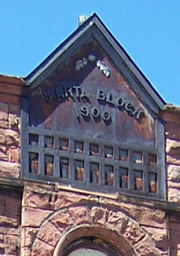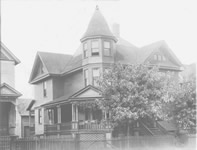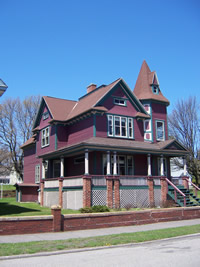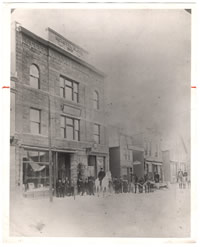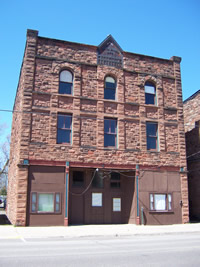Duncan Campbell House I Duncan Campbell bought this lot in 1898 for $500 and sold it a year later for $4,900, presumably with a new house on it. The buyer was Clara J. Douglas, who lived there with her husband, Frank, an insurance agent. In 1902 Thomas J. Hoatson paid $7,200 for the house, which he and his family occupied while his own house at 320 Tamarack was under construction. In 1910, William R. Stannard, who was in insurance and real estate businesses, lived there with his family.2 The house has been stripped of its wraparound front porch, but the old photograph shows how it originally appeared. The porch, corner tower, and cross gables on the hip roof contributed to its picturesque design. Aluminum siding now covers the first floor and shingles the second.
Grimmer House Henry Grimmer, a grocer, commissioned Campbell to design this relatively modest house and lived there only briefly. The newspaper said that “the style of architecture is colonial design, there being a large veranda in front with a balcony above it.” It went on to describe a parlor, dining room, library, and kitchen on the first floor with such amenities as a bay window in the dining room and double doors between the parlor and dining room. The second floor had four bedrooms. The house was to be heated by hot water and lit by electricity.3 Today there is no longer a balcony over the front porch and the house has been clad in vinyl siding.
Galbraith House William J. Galbraith, a lawyer, had this house built for $5,000. Galbraith was involved in at least one famous case: he defended the deputies who were accused of killing strikers in their home in Seeberville, a neighborhood of Painesdale, during the 1913-14 strike. After the conviction of four deputies, the Copper Range Company hired another lawyer for their appeal.4 Galbraith lived in this house with his wife, two children, mother-in-law, father, servant, and a woman described as a roomer.5 The Queen Anne-style house has a corner tower and a cross-gable roof. There is a wraparound porch across the front. The newspaper described a parlor, sitting room with fireplace, dining room, library, and a large bedroom on the first floor, as well as a kitchen and pantry. On the second floor were three bedrooms, a bathroom, and a sewing room. The house had electric lights and hot-water heat.6
Duncan Campbell House II When Duncan Campbell designed this house for himself, he placed it across the street from two of his other accomplishments: 205 and 209 Pewabic. His own house was slightly more modest, not having a tower, but it had a porch across the front, a bay window on the side, and an intricate hipped roof with cross gable and gabled dormer. The first floor included a “large reception hall,” a parlor, and a dining room. “These three rooms are all paneled with quarter-sawed oak to a height of 4 feet from the floor. The walls are calsomined and are beautifully tinted with muresco colors,” the newspaper reported. On the second floor were four bedrooms and a bathroom which contained “a bath shower with rubber curtain and all bath fixtures complete.” The front room on the second floor opened onto a balcony, now enclosed. The second-floor woodwork was painted with a white enamel. On the third floor were three bedrooms and a storeroom. The house’s cost was estimated at $4,500.7
Bessolo House Campbell designed this modest house for Matthew Bessolo, an employee of Calumet & Hecla, who also served as a Laurium village trustee in 1905. The two-story house had an open porch and a cross-gable roof. Inside were double parlors connected by folding doors, dining room, kitchen, and pantry. On the second floor were four bedrooms.8 The building’s vinyl siding obscures some detail.
Richetta Block Michael Richetta commissioned this business block constructed of Portage Entry sandstone. Originally planned to be two stories with the capacity of having a third or even fourth story added, it appears to have been built as a three-story building. The 42-foot front was divided into two commercial spaces, one 25 feet wide (occupied by Superior Pharmacy in the photograph) and the other 12; the stores had plate-glass windows and steel ceilings. The center bay of the façade was pulled forward slightly and crowned with a name plate: RICHETTA BLOCK 1900. The second and third floors’ twelve rooms were designed as office spaces that could be joined into two- or three-room suites. Occupants indicated in the photograph included Hagen & Reed Insurance and Real Estate and an unidentified lawyer. The building was heated by steam and lit by electricity.9
Marta Block Campbell designed the three-story building known as the Marta Block, also constructed of Portage Entry sandstone, on the same block as the Richetta Block. Three bays wide, the building stretched 42 feet across the front. Most of the stone is rough-faced, random laid, but it is accented by beltcourses of smooth-faced sandstone. The third-level windows have round arches. On the first floor, the two commercial spaces had separate entrances and were equipped with “the latest improvements, steel ceilings, plate glass fronts and the like.” A third doorway led to offices on the second floor. The third floor was planned to contain a lodge room or hall “fitted in the modern style.” A small pediment at the cornice contains a metal plaque that proudly proclaims “MARTA BLOCK 1900.” The building was estimated to cost $12,000.10
|
